Gold jewelry photography can be challenging, but that doesn’t mean capturing stunning pieces in all their glory is impossible. However, it requires finesse, proper equipment and setting, and specific techniques for creating visually striking photos.
Are you ready to photograph gold jewelry like a professional? This ultimate guide addresses gold jewelry photography ideas, expert tips, essential equipment and techniques, and examples for inspiration. You’ll also discover an excellent AI product photography tool for saving time and resources. Let’s dive in.
In this article
Understanding Gold Jewelry Photography
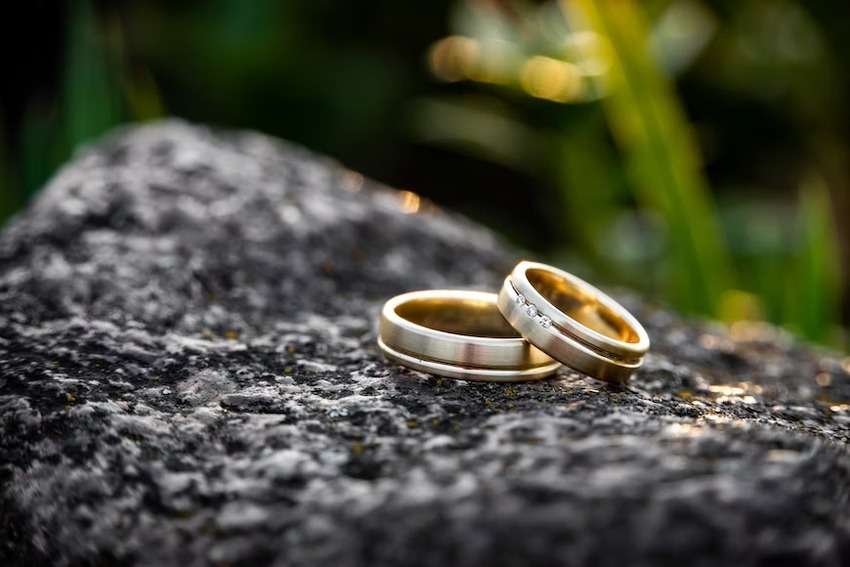
Photographing gold jewelry differs from snapping shots of fashion jewelry. The latter comprises synthetic materials and base metals that may not share gold’s reflective properties.
Additionally, gold is a status symbol. It’s a timeless metal that maintains its shine and continually increases in value. Therefore, gold jewelry photos should exude that classic style and elegance.
Here are the crucial factors for achieving that effect.
Challenges specific to capturing gold jewelry
The most significant challenge of capturing gold jewelry is its reflective surface. The precious metal reflects light, producing unwanted glare and shadows.
Gemstones, primarily diamonds, are also reflective, and their colors aren’t as vibrant in photos as in real life, calling for retouching in post-production.
Another challenge is the jewelry’s size. Capturing small items requires proper camera settings, including a wide aperture and sharp focus.
Group jewelry photos are even more demanding since you must work with a shallow depth of field. Focus stacking can help, but it requires extensive post-processing.
Importance of accurate color representation and reflection management
Accurate color representation is critical in gold jewelry photography because consumers must know how various pieces look to make informed purchasing decisions.
For instance, amethyst and tanzanite have similar colors. Showcasing amethyst’s purple and tanzanite’s violet-blue hues helps customers pick their desired jewelry. The same goes for the precious metal’s color shades: white, yellow, and rose gold.
Reflection management is vital for the same reason. Images with unsightly glare and shadows don’t look appealing, driving customers away.
Role of lighting and backdrop selection in enhancing gold jewelry images
Lighting is the most critical factor in gold jewelry photography. It helps highlight the features, maximize gold’s beauty, and take stunning shots. It can make or break any image, not only jewelry-related.
Backdrops can also enhance gold jewelry images. They set the mood, convey brand messages, and make jewelry more appealing, compelling consumers to purchase it.
Now that you understand this photography type, it’s time to see what equipment you need for a gold jewelry shoot.
Essential Equipment for Gold Jewelry Photography

Whether shooting jewelry-only or gold jewelry model photos, you’ll need the following equipment to capture excellent shots, impress clients, and help them drive sales.
Camera selection for capturing intricate details
You don’t need a high-end camera to capture intricate details—a smartphone with a high megapixel count can do the trick. However, mirrorless and DSLR cameras are best for top-notch gold jewelry photos.
Pick a camera supporting RAW shooting, a wide aperture, and manual settings for adjusting the shutter speed, focus, white balance, ISO, and other features. Even an entry-level camera will do.
Lens options suitable for close-up shots
Macro lenses are ideal for product close-ups as they let you magnify jewelry to capture intricate details without sacrificing quality. Choose those with short focal lengths (between 50 and 60 mm), a minimum focus distance of 30 cm, and a 1:1 magnification ratio.
Read more: best lens for jewelry photography
Tripods and stabilization for steady images
Blurry images due to unsteady hands won’t do you any favors. Fortunately, you can stabilize your camera with a tripod to maintain crisp focus, be consistent with your angles, and prevent shaky photos.
Additionally, you can use a remote shutter release to shoot images from a distance and avoid the notorious camera shake.
Reflectors, diffusers, and light modifiers for optimal lighting control
Reflectors are crucial for redirecting light to the subject and reducing shadows. Diffusers stand between your gold jewelry and the light source, softening the light and eliminating glare. You can use any translucent material to diffuse light, like a white curtain or foam board.
You’ll also need light modifiers—photography umbrellas, softboxes, light cones, V-flats, or a lightbox. They’re ideal for optimal lighting control, helping you take glare-free gold jewelry photos with minimum shadows.
Setting Up the Photography Environment
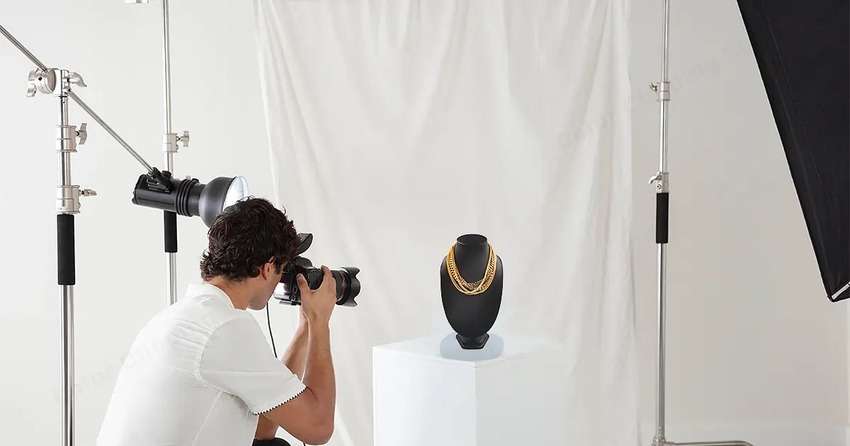
Once you get the necessary equipment, follow the tips below to set up the photography environment for your gold jewelry shoot.
Choosing a suitable backdrop for gold jewelry
Most photographers choose a solid white backdrop like paper sheets, poster boards, fabric, or matte vinyl when shooting gold jewelry for ecommerce stores. That way, they can highlight the jewelry’s features because a white background minimizes shadows and reflections and ensures accurate color representation.
However, a black backdrop can make gold jewelry photos more dramatic, making it perfect for exuding luxury and style. It creates contrast, primarily with white and yellow gold and light-colored gemstones, putting the jewelry into the spotlight.
A darker background can also emphasize textured designs and intricate details and make the colors pop. For instance, it can work wonders for white gold jewelry with diamonds or colored gemstones like emeralds.
More tips:
Diamond jewelry photographyGemstones photography
Controlling reflections and minimizing glare
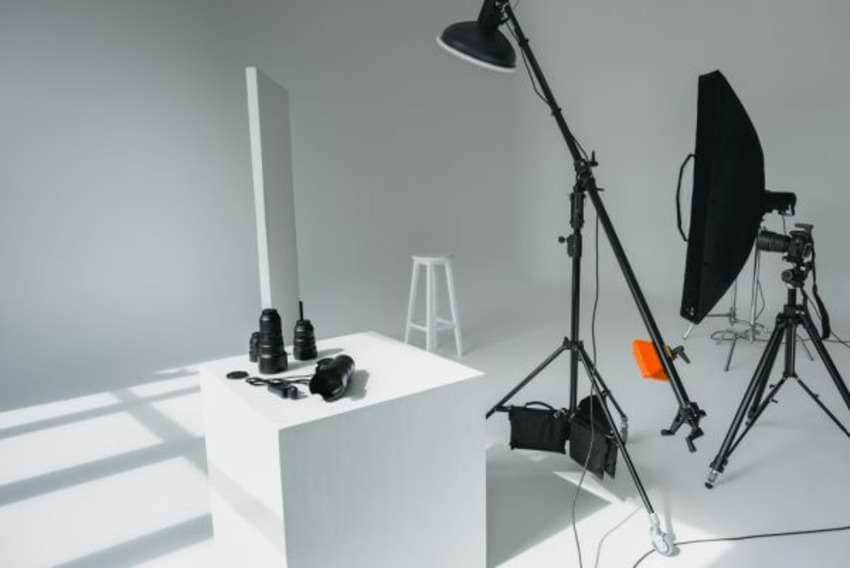
Place a reflector opposite your light source at a 45° angle to minimize reflections and glare. That way, you’ll redirect the light to the subject without shining directly on the jewelry.
Next, put your diffusers or light modifiers like umbrellas between the jewelry and the light source (also at 45° angles) to scatter and soften the light, eliminating glare and reflections.
Finally, place your camera on a tripod facing the gold jewelry, keeping a close distance from the subject.
Creating a suitable lighting setup for gold jewelry
If you rely on natural light, control it with reflectors and diffusers while placing your subject on a table at a 90° angle relative to the window. Get closer to it to leverage soft lighting, which is best for jewelry photography.
If you use artificial lighting, opt for directional LED lights, not your on-camera flash. They’re ideal for soft, uniform lighting during a gold jewelry shoot. Keep them at 45° angles so they don’t shine directly on the gold jewelry, and don’t forget diffusers.
Utilizing props and accessories to enhance the overall presentation
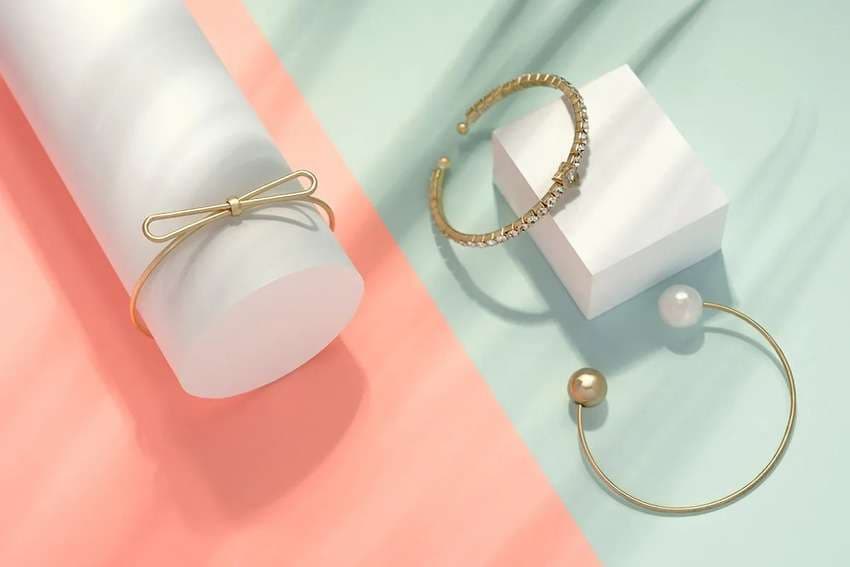
Props and accessories in gold jewelry photography can improve the aesthetics or be practical. Either way, they enhance the overall presentation and add that “je ne sais quoi” to your photos.
Some examples are jewelry boxes, necklace busts, ring and bracelet holders, and earring stands. However, you can include natural elements like flowers, petals, leaves, wood, tree bark, pebbles, marble, stone, concrete, sand, and seashells to add visual interest and make gold and gemstones pop.
Lighting Techniques for Gold Jewelry Photography
Now that you have your lighting setup for a gold jewelry shoot, it’s time to experiment with lighting techniques to make the jewelry shine.
Understanding the impact of different lighting angles
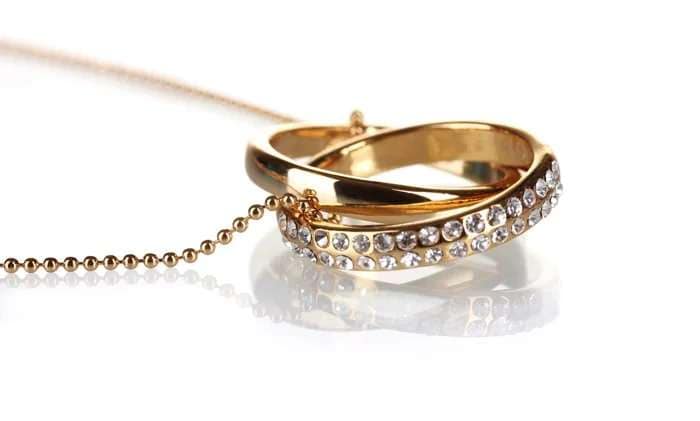
You know that lighting angles determine the brightness and darkness in your photos. However, they also set the mood and tone, helping you add dimensional depth and quality.
That primarily rings true for side lighting, which creates a 3D effect perfect for enhancing textured gold or background surfaces and showcasing intricate details.
Therefore, change your light source’s direction to experiment with different angles and adjust your reflectors and diffusers accordingly. You’ll see how each illuminates the jewelry and affects its colors and texture.
Effective use of natural light and artificial lighting options

Natural light is your best friend when photographing gold jewelry. It provides a soft, uniform glow that emphasizes the jewelry’s top features.
Are you thinking about adding artificial light to the equation? Don’t. Mixing light sources will negatively affect your photos because of different color temperatures.
However, you can’t always work with natural light, so invest in a lightbox and directional LED lights. Diffuse them to scatter light beams and soften shadows while showcasing gold’s tonal gradients.
Managing highlights and shadows to showcase texture and details
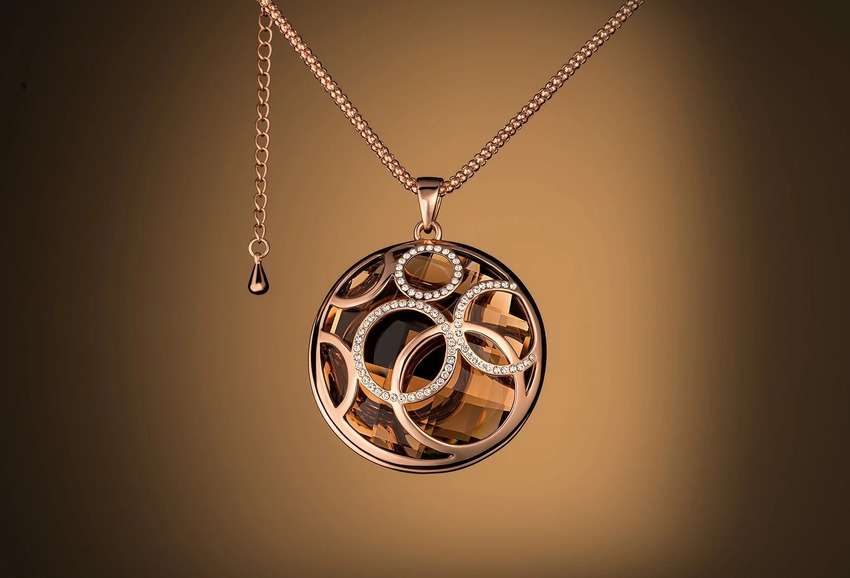
What makes a gold jewelry photo impressive? The details. Those details are typically in the highlights and shadows—the brightest and darkest areas where you can see the tiniest intricacies. They add contrast, tone, depth, and drama to your images.
Therefore, experiment with your camera settings (aperture, shutter speed, and ISO) to maximize dynamic range—the ratio between highlights and shadows. Of course, you can adjust them in post-processing, but that’s challenging with overexposed or underexposed photos because they have less tonal data.
Experimenting with backlighting for a captivating visual effect
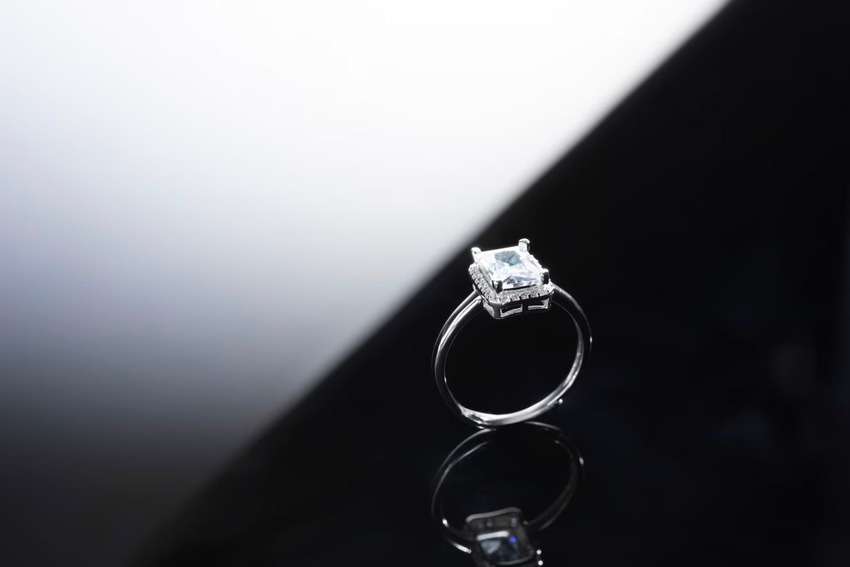
Backlighting adds contrast to photos, making them more dramatic. It can work wonders for gold jewelry photography, primarily when shooting pieces with translucent gemstones.
Achieve this stunning visual effect by positioning your light source behind the subject, ensuring it shines directly through the gemstone. Adjust it so it doesn’t misrepresent the gem’s shape while making the jewelry’s form and edges prominent.
Composition and Styling Tips for Gold Jewelry Photography
Composition adds visual interest to your photos. How you arrange the elements within the frame, including the jewelry and props, will determine how viewers perceive the products, influencing their purchasing decisions.
Here are the essential tips for styling gold ring and necklace and creating eye-catching compositions.
Highlighting the unique features of gold jewelry
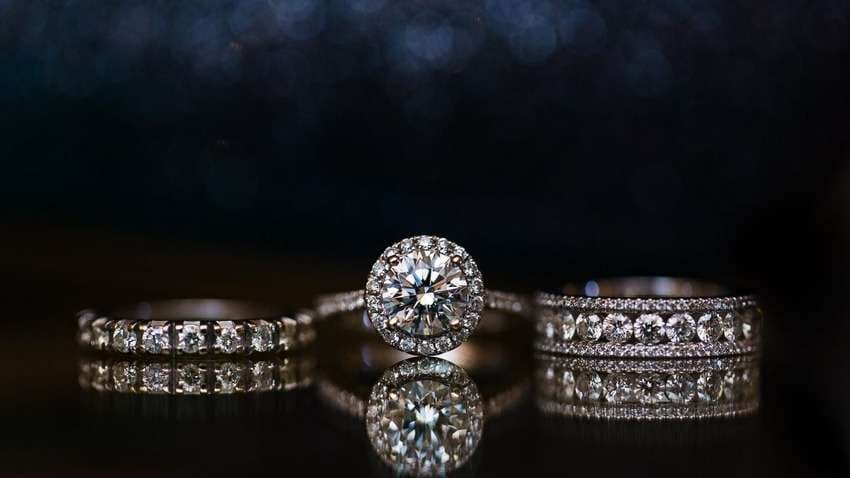
Gold jewelry photography is all about highlighting unique features. Are you photographing a diamond ring? Take a front-view shot to put the gemstone in the spotlight. Does it have a double-shank design? Accentuate it with a three-quarter angle.
Experiment with different angles to create the best composition that captivates viewers.
Utilizing complementary colors and textures in the composition
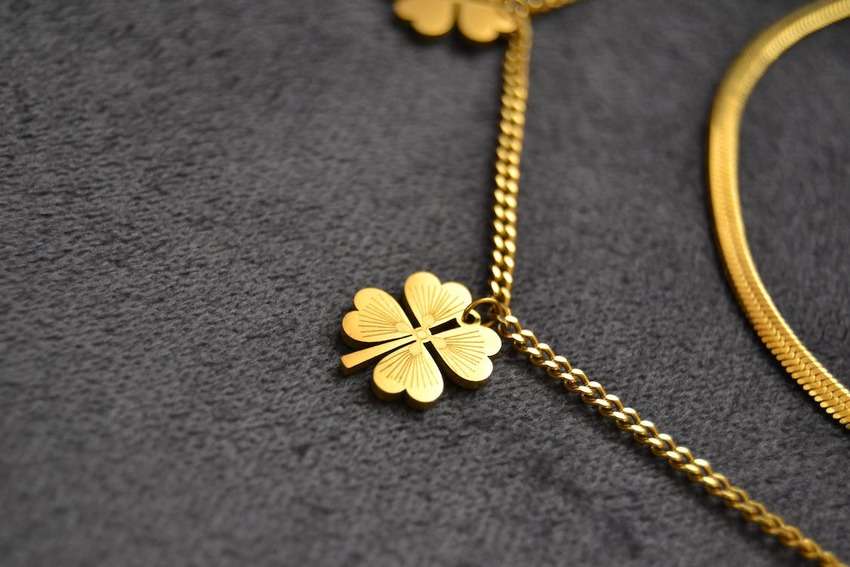
Complementary colors—those opposite each other on the color wheel—add vibrance to gold jewelry photos, making them more visually appealing. For instance, orange and blue, red and green, and violet and yellow are complementary pairs.
You can use a solid color background during your gold jewelry shoot to keep the composition clean. However, you can add more depth and visual interest by implementing texture.
Whether you place your subject on a textured surface or add abstract effects in post-processing, you’ll breathe new life into your photos and make the jewelry pop.
Showcasing different angles and perspectives for more variety

Consumers expect to see jewelry pieces from all angles to make informed purchasing decisions. That’s why snapping shots from different perspectives is crucial. You’ll provide more variety, helping clients create impressive product catalogs that convert.
Incorporating props and backgrounds that enhance the jewelry’s appeal
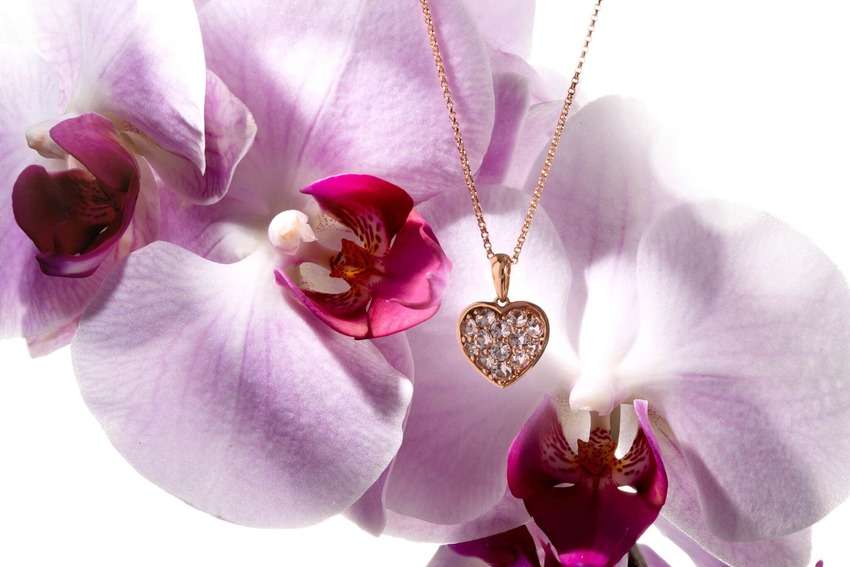
The colors and texture you add to your gold jewelry photos go beyond your shooting table and post-processing effects. You can use props and leverage anything around you for a captivating background.
The picture above is an excellent example since the pink orchid’s unique, patterned petals with vivid colors accentuate the gold heart-shaped pendant.
Showcase of Inspiring Gold Jewelry Photography
What’s the point of learning gold jewelry photography if potential clients can’t see your work? That’s why a photography portfolio is crucial. It showcases your talent, adds credibility, and demonstrates your artistic value. Here’s how to make it stand out.
A curated collection of stunning gold jewelry images
Enriching your portfolio with stunning gold jewelry images will help you get more relevant projects. Therefore, create a collection of your best work to impress potential clients and entice them to contact you to take shots for their product catalogs.
Analysis of techniques and elements that make the images stand out
Featuring your best work will attract clients, but analyzing the images will take your brand to another level.
Detailed analyses of the techniques and elements you used to make each image stand out will demonstrate your knowledge and expertise. Additionally, relevant content will improve your SEO, boosting your online visibility and website traffic.
Drawing inspiration from successful gold jewelry photography examples
Learning from professional photographers is the best way to hone your skills. Seeing how experts in your field photograph gold jewelry can help you understand various techniques and get inspiration for your portfolio.
We’ve found some excellent examples on Behance featuring Aleksa Torri’s gold ring photography on natural backgrounds.
The photographer used a natural wood background for this photo to accentuate the wedding rings’ white and yellow gold colors and texture.

He used tree bark to highlight these textured gold wedding bands, creating an appealing look.

The photographer used black wood as a background for the composition below, adding contrast and drama and highlighting the white gold wedding bands’ elegance.

The photo below adds the most visual appeal. The barred bird feather and sand make the uniquely textured white-and-yellow gold ring look breathtaking.
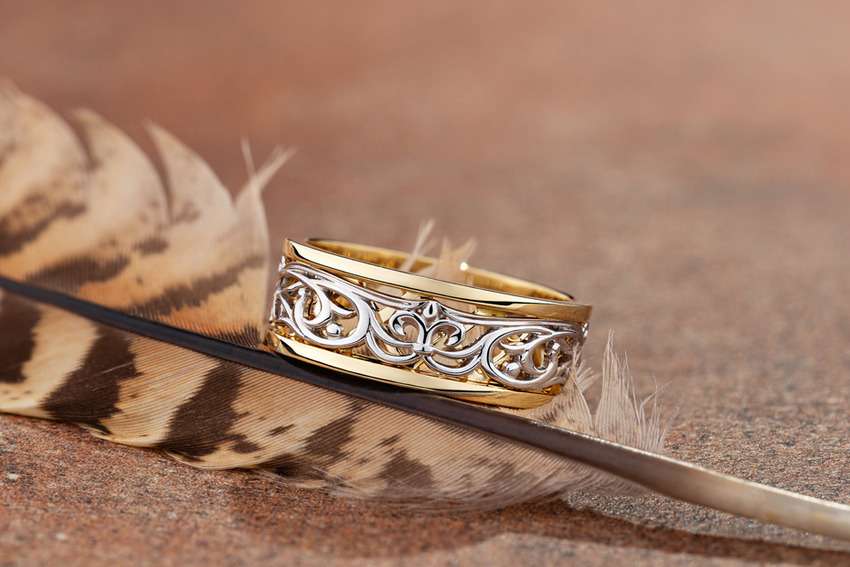
These examples are only the tip of the iceberg, so draw inspiration from many other successful gold jewelry photographers.
[NEW TREND] Create Gold Product Photos With AI
AI product photography tools can create photos within seconds, adding your desired backdrop, background color, lighting, camera angle, props, and other elements. They can even generate gold jewelry model photos for lifestyle or editorial photography.
For instance, Wondershare VirtuLook can generate AI product photos following a text prompt. It lets you describe your vision and provides multiple 4K images within seconds.
Here’s how to use it:
- Step 1: Visit Wondershare VirtuLook and sign up for an account. Or log in directly.

- Step 2: Once you log in, Go to Product photo generation to upload reference product photos. Pay attention to the photo's quality that you upload.

- Step 3: Change the background until you find the matchable one for your gold jewelry under Using Template in the "Product photo generation..

- Step 4: Lastly, you can download or bookmark the photos you like. We also appreciate timely feedback from you regarding any issues with image quality or any other concerns you may have.
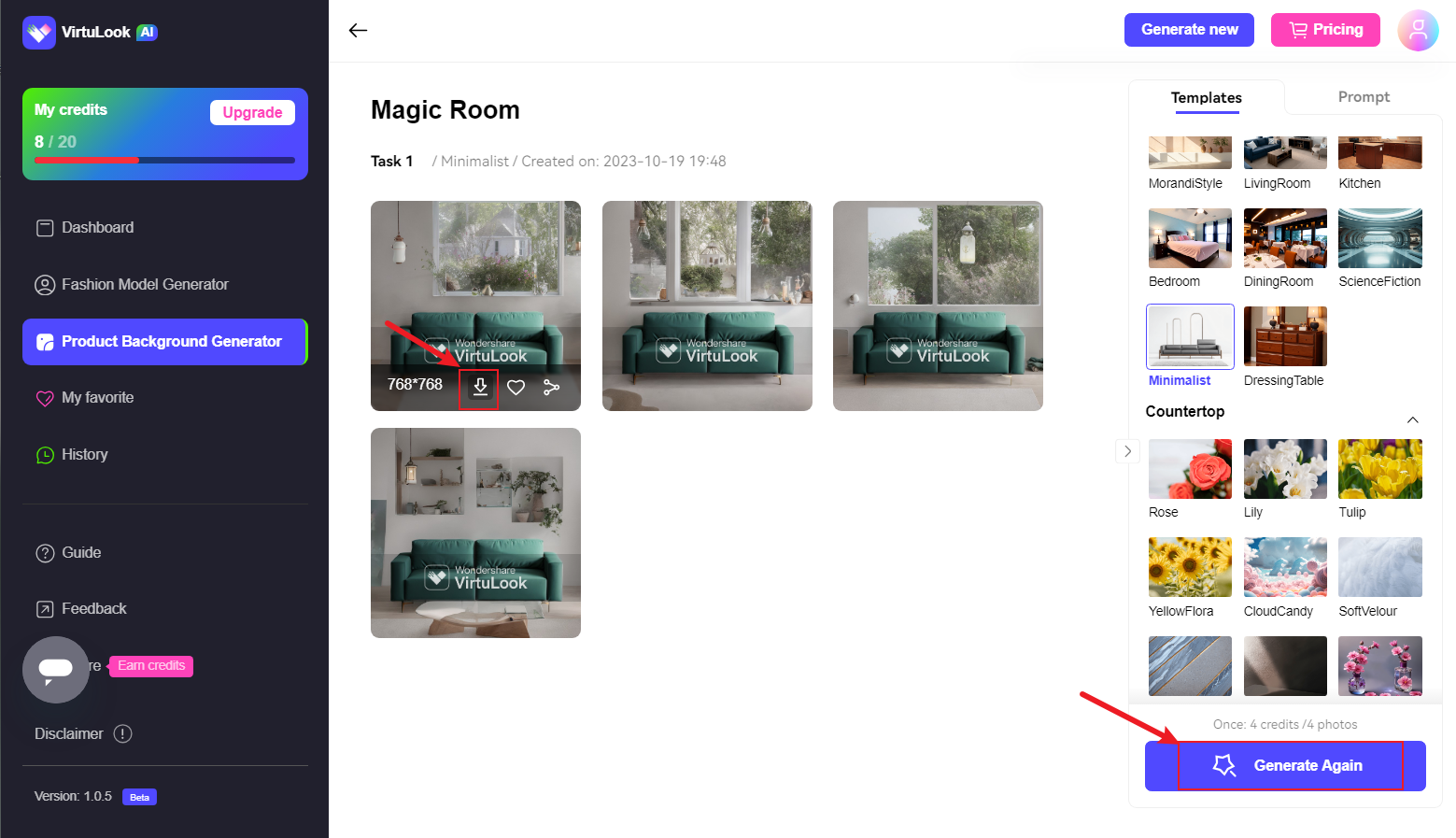
Wondershare VirtuLook is an excellent tool for saving time while getting studio-quality product photographs at a fraction of the cost.
Conclusion
Gold jewelry photography may be demanding, but you’ll get the hang of it quickly with our tips and techniques. However, explore other resources to master the field, practice daily, and get your creative juices flowing.
Don’t forget AI tools like Wondershare VirtuLook to save time and draw inspiration. The best photographers leverage cutting-edge technology and think outside the box.

![The Ultimate Guide to Gold Jewelry Photography [+ AI Solution]](https://images.wondershare.com/virtulook/articles/gold-jewelry-photography-1.jpg)